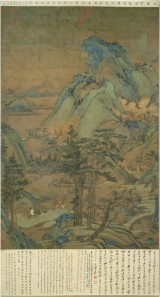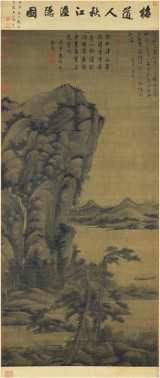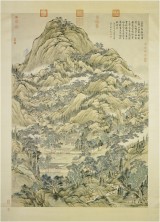TELDAP Collections
| Oversized Hanging Scrolls |
|
This work was bequeathed to the National Palace Museum by Chang Dai-chien. Bluish-green peaks tower over green waters for a scene with the essence of spring. On foreground slopes are lofty pines with a group of travelers, the figures rendered in great detail. The painting has no seal or signature, but the colophon below by Chang Dai-chien cites an inscription by Zhao Mengfu of the Yuan ascribing it to Dong Yuan, a native of Zhongling (Nanjing) in Jiangnan. Records mention Dong's ink painting as like Wang Wei's and his color works similar to Li Sixun's. This work was first done with hemp-fiber texturing for the mountains and rocks, with ochre added to the background. Then layers of malachite and azurite washes were added, thus revealing traces of Dong's manner.
This painting depicts a pure stream flowing among rocks with tall pines shading a slope. Two scholars sit there on mats, one playing a ruan lute as the other pauses playing a qin zither to listen; an attendant to the side with a fruit platter waits on them. Though the signature in the upper right indicates the artist is Zhao Mengfu of the Yuan, it is probably a spurious later addition. The theme of pausing the qin to listen to a ruan became popular in the Ming dynasty, with both blue-and-green and monochrome ink styles seen here. The arrangement of figures is also more or less similar, as if a Ming artist had composed it and added the name of a famous previous painter. Though ascribed to Zhao Mengfu, the style suggests this work was done around the 17th century.
This work depicts a land of immortals, where a waterfall echoes among mountains. Buildings and pavilions rise in tiers above rushing waters. An immortal in Taoist garb holds a flywhisk and sits on a daybed. On the path and in the buildings are other immortals. The artist used coarse brushwork to first broadly outline the rocks and mountains, then adding details with a finer brush. After applying blue and green washes, he also used gold ink, giving the landscape a glittering atmosphere suiting this realm of the immortals. The old attribution is to the Yuan artist Hu Tinghui, a spurious signature of his appearing at the right. The overall style is actually closer to the middle or late Ming, probably the work of a gifted later artist with Hu's name added.
Wu Zhen (style name Zhonggui; sobriquets Meihua daoren, Mei daoren) was a native of Jiaxing in Zhejiang. In landscape painting, he followed the Five Dynasties artist Juran, absorbing the styles of previous masters to establish his own personal manner. In this painting, a waterfall plummets between the layers of a precipitous cliff. Houses in a village are scattered amongst thick trees and rocky slopes, while in the far distance stretches an expanse of water, where a small, solitary fishing boat is adrift. A centered worn brush was used throughout the work, the artist combining forceful texturing with thick layers of semi-translucent ink washes to render the cliff. The sturdy pine trees also add a sense of strength and solidity.
Qian Weicheng (style name Zongpan, sobriquet Chashan), a native of Wujin in Jiangsu, was the top civil service candidate of 1745, going on to serve as Vice Minister of Punishment. As a youth, he studied flower painting with his grandmother Chen Shu. He later studied the landscape styles of the Yuan artist Wang Meng and Wang Yuanqi of the early Qing, also receiving instruction from Dong Bangda to become a leading artist at the court then. His works feature tightly organized compositions and vigorous yet elegant brushwork. This painting is an overview of Qixia Temple in Jiangsu. Here are forested hills and valleys with clinging mists and clouds, the temple and village buildings scattered to create an extremely serene and beautiful scene.
Text and images are provided by National Palace Museum
|

















